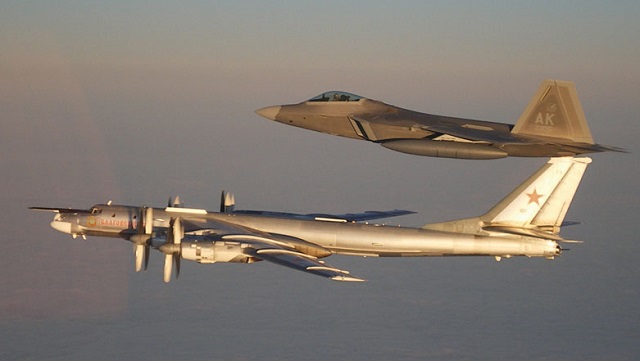At a time when budget constraints are driving the US Air Force to divest fighter and attack aircraft faster than they can be replaced with the Lockheed Martin F-35, outgoing chief of staff Gen Mark Welsh says it would not be a “wild idea” to resume production of an improved version of the F-22 Raptor air superiority jet.
The Pentagon’s latest aviation inventory and funding plan says the flying branch has “insufficient resources” to maintain the 1,900 warplane level mandated by Congress beyond the current five-year budget blueprint that extends to fiscal year 2021.
The number of combat-coded fighter jets and their associated squadrons “will substantially drop” between 2022 and 2026 before hitting its lowest level in 2031 as the Fairchild Republic A-10 "Warthog" and other long-serving fighters are retired to the boneyard.
Asked about solutions to reverse this trend at an Air Force Association forum in Washington DC on 26 May, the general who flew the F-16 and A-10 says money is the main issue. America, he says, needs to decide if it wants to continue to be a globally deployed superpower in the next 20, 30 or 50 years and then fund its military accordingly.

US Air Force
The air force currently spends most of its aircraft procurement dollars on the F-35A multi-role fighter, Boeing KC-46A tanker and Lockheed C-130J tactical transport, but Lightning II production rates have been truncated at 48 aircraft per year through this decade, only rising to 60 copies per year in 2021 from Fort Worth, Texas. The service has no plans to buy more fourth-generation Lockheed F-16s or Boeing F-15s, and has slowed its pursuit of a sixth-generation type as it considers the best way to proceed in a tight budget environment.
One answer could be to resume Raptor production, with just 195 of those supermanoeuvrable combat planes delivered by the Lockheed, Boeing and General Dynamics F-22 industry team from Marietta, Georgia through 2012. It is powered by the Pratt & Whitney F119.
The programme was terminated by then defence secretary Robert Gates in a move described by the current head of US Air Combat Command as perhaps the “biggest mistake ever”. Until recently, Welsh and the secretary of the air force Deborah Lee James have been saying that reviving the F-22 line would be “cost-prohibitive” and a “non-starter”. Now, the air force appears to be changing its tune.
“I don’t think it’s a wild idea,” says Welsh, who notes that the air force is already working with Lockheed to figure the exact cost and the "pros and cons" of such a scheme. "I think it’s proven that the airplane is exactly what everybody hoped it would be.
“We’re using it in new and different ways. It’s been spectacularly successful and its potential is really, really remarkable,” he continues.

US Air Force
Congress is considering a provision in its fiscal year 2017 defence policy bill that would require the air force to provide a cost breakdown and even consider foreign involvement in the project by 1 January 2017, but Welsh expects an answer about the cost much sooner.
“It’s not a crazy idea,” he says. “I think you’ve heard the secretary in the past say, and the air force say, that we think it’s cost-prohibitive. We’re going back right now and looking in detail at the number.”
The F-22 was conceived in the 1980s as an advanced F-15 replacement and it first flew in 1997. The aircraft was beset by technical difficulties and costs quickly escalated as the Pentagon’s F-22 requirement dropped from 749 to 381 and finally 187 production units.
The programme was terminated in favour of other investments, such as delivering the F-35 Joint Strike Fighter, which the service will declare ready for combat later this year.
Asked on 24 May if investment in costly stealthy technology, which is inherent in pricey aircraft like the Northrop Grumman B-2 and Lockheed F-22 and F-35, is causing structural budget problems and forcing fighter numbers down, US Defense Department acquisition czar Frank Kendall said it was more of topline budget issue, caused by sequestration and the Budget Control Act of 2011.
“Unless something is done about the budget situation, it’s going to be very, very difficult for us to support [the American military strategy]. What we’re buying with the F-35, on a dollar-for-dollar basis, is the most combat power we can get for our dollar,” Kendall contends.
“It’s not just about the numbers, it’s about the capability. From the stories we’ve heard here from the operators about the effectiveness of the F-35 against fourth-generation aircraft were extremely impressive. Having a less expensive and less capable aircraft is not the answer to our problems.

US Air Force
Lockheed Skunk Works, which is leading the world’s largest defence contractor’s F-X efforts, has proposed upgrades to existing types like the F-22 and F-35 as the best way to achieve air superiority in the 2030s. Other combat aircraft manufacturers like Northrop Grumman and Boeing would probably prefer a competition to introduce a next-generation warplane.
Welsh suggests that an improved F-22 might be preferable and more affordable than some type of sixth-generation fighter.
“Rather than thinking of a sixth-generation fighter, can you modify the F-22 and re-open the line cheaper and keep the numbers up?” he says. “I don’t know. We’re working on that right now. We’ve got to open the spectrum a little wider about how we’re going to get the job done 20 years from now.”
Source: FlightGlobal.com











































